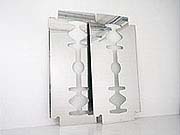20/10/2001
Sylvie Fleury
Magasin, Grenoble
The exhibition occupies all of the Magasin's exhibition spaces and brings together very recent pieces and a significant number made specially for the occasion. It can be considered an important step in the artist's career. From the start, Sylvie Fleury has borrowed and crossed references, objects, images and aesthetics that come from the worlds of fashion, girls' clubs, car racing, etc.

Razor Blade, 2001
Sylvie Fleury's exhibition occupies all of the Magasin's exhibition
spaces and brings together very recent pieces and a significant number
made specially for the occasion.
It can be considered an important step
in the artist's career.
From the start, Sylvie Fleury has borrowed and
crossed references, objects, images and aesthetics that come from the
worlds of fashion, girls' clubs, car racing, etc.
Sylvie Fleury belongs to
the generation of artists who appropriate elements that come from the
non-artistic universe, and at the same time rupture with the likes of
Marcel Duchamp whose manufactured bottle-holders placed in the
museum setting became works of art.
Until the 1980s many artists, the
last amongst them, for example Jeff Koons, utilised cultures
heterogeneous to art to reformulate essential questions regarding the
status of the art object (the work), its presentation (the exhibition) and
institutional discourse (the museum or art centre).
Sylvie Fleury's
attitude, qualified by art critics as "post-appropriationist", stages the
coupling and juxtapositioning of separate systems, scrutinizes the
tensions created between them ("contextual leaps") and the cultural
techniques and lifestyles of their users and their destinations.
Her main way of intervening is by "customizing".
In an exemplary way
she often uses the world of fashion which feeds off this tension and her
"customizing" by playing with terms that are contradictory, the
dictatorship of collective taste and the desire to personalise objects.
The questions posed by fashion also allow her to voice a post-feminist
stance that endeavours to destabilise stereotypes by feminising objects
or contexts that reflect the masculine system of symbols.
She-devils on wheels headquarters, 1998
This customary institutional argument aside, the main interest of this
exhibition is that it makes an addition to the set of objects and
collections of extra-artistic signs used by Fleury.
The "Rue" area is
entirely given over to She-Devils on Wheels (1998), which combines a
monumental wall painting of stylised flames, the hulks of old cars, oil
drums, tyres and the accessories offices of a women's club that advises
visitors on the technical or decorative customising of their vehicles.
The
work takes its title from Herschell Gordon Lewis' film of the same name
made in 1968.
In the same way, the world of fashion is present in the new piece Prada
(made with the support of the company), which recreates one of the
eponymous brand's stores, complete with its seasonal collection.
For the most part, though, the pieces are articulated around a vast
territory evoked by the caption of the image on the invitation and poster:
"Identity/Pain/Astral Projection". This embraces various fields of
knowledge and representation, referencing both spirituality and
"scientific" apparatus for interpreting the world on the basis of "natural
elements".
Seven, 2001
Pierre Van Obberghen, a chromotherapist, has collaborated throughout
the exhibition, including with the lighting for the Prada boutique.
He
designed the Matrix Cube room at the back of the exhibition.
In this
space visitors can consult his chromotherapy software and study the
graphs on the wall. Those who put on the necessary white overalls can
discover the white Chromogang room, coloured using a special
technique and filled with Piero Gilardi's sound-making rocks/seats.
AVS 5, comprising the eponymous apparatus along with hospital
equipment and a computer, enables visitors to visualise their aura.
The
Bibliothèque Soleil consists of 8.000 volumes which have been
acquired and then classified with the help of a nature therapist.
Objects symbolising these "beliefs" are made on a monumental scale
(the luminous Giant Chromo Quartz and the Seven pendulums).
Direction : Yves Aupetitallot
MAGASIN - CENTRE NATIONAL D'ART CONTEMPORAIN
Site Bouchayer - Viallet
155 cours Berriat
38028 Grenoble Cedex 1
FRANCE
Tel. + 33 (0) 4 76 2195 84
Fax + 33 (0) 4 76 21 24 22



